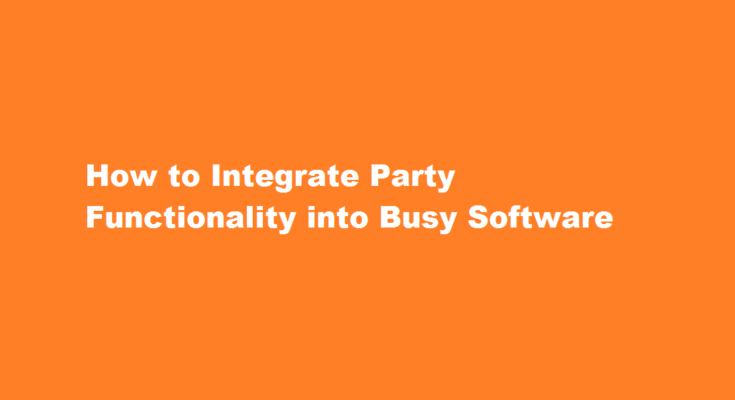Introduction
In today’s fast-paced world, where connectivity and social interactions play a crucial role, software developers are constantly looking for ways to enhance user experiences. Adding party functionality to busy software is an effective means to create a collaborative and engaging environment. In this article, we will explore the steps and considerations involved in integrating party features into software, ensuring a unique and informative experience for users.
Define the Purpose and Scope
Before embarking on integrating party functionality, it is vital to define the purpose and scope of the feature. Will it be used for social interactions, virtual events, or collaborative work environments? Understanding the intended use will help shape the design and development process.
Identify Key Features
Next, identify the key features that will make the party functionality valuable to users. These may include real-time chat, audio and video communication, screen sharing, file sharing, and interactive activities. Consider the specific needs of your software’s target audience to determine the features that will enhance their experience and boost engagement.
Choose an Integration Approach
Selecting the right integration approach is crucial for a seamless party experience. Depending on your software’s architecture and requirements, you may opt for integrating a pre-built party API or building custom party functionality from scratch. Evaluate the available options and choose the one that aligns best with your software’s needs.
Design User-friendly Interfaces
A successful party integration relies on intuitive and user-friendly interfaces. Ensure that the party features blend seamlessly with the existing software’s design. Implement clear navigation menus, recognizable icons, and logical workflows to enable users to navigate effortlessly and maximize their participation in parties.
Implement Real-time Communication
Real-time communication lies at the core of party functionality. Integrate reliable and scalable communication technologies, such as WebRTC (Web Real-Time Communication), to facilitate audio and video calls. Implement features like chat rooms, private messaging, and notifications to enhance real-time interactions among participants.
Ensure Privacy and Security
implement appropriate access controls, encryption measures, and moderation tools to protect users’ personal information and prevent unauthorized access. Enable users to control their privacy settings and provide transparency regarding data handling practices.
Support Multi-platform Accessibility
To ensure inclusivity and maximize user reach, support multi-platform accessibility. Develop party features that can be accessed across various devices, including desktops, laptops, smartphones, and tablets. Offering cross-platform compatibility will enable users to join parties regardless of their preferred device or operating system.
Test and Iterate
Thorough testing is essential to identify and address any bugs or usability issues. Conduct user testing sessions to gather feedback and insights. Iterate on the party functionality based on the feedback received, ensuring continuous improvement and an optimal user experience.
FREQUENTLY ASKED QUESTIONS
What can not be modified in busy software?
You cannot change the original beginning F. Y. once it is saved. You can go to the successive financial years but cannot go to the F. Y.
Can we delete financial year data of a company through busyness?
To delete a Company or single financial year click Company → Delete Company/Single F.Y option. Select Company to be deleted, enter valid User name and password and then select whether you want to delete complete company or single financial year.
Conclusion
Integrating party functionality into busy software can greatly enhance user engagement and collaboration. By following these steps and considering the needs of your target audience, you can create a unique and informative party experience. Remember to prioritize user-friendly interfaces, real-time communication, privacy, and security. Continuously test and iterate to ensure the party features align with evolving user expectations and preferences. With a well-designed party integration, your software can foster social interactions and provide a dynamic and engaging environment for users.
Read Also : Streamlining Busy Work Mastering The Art of Item Descriptions



